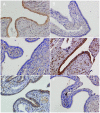Biomarker expression in normal fimbriae: Comparison of high- and low-grade serous ovarian carcinoma
- PMID: 23162641
- PMCID: PMC3499561
- DOI: 10.3892/ol.2012.877
Biomarker expression in normal fimbriae: Comparison of high- and low-grade serous ovarian carcinoma
Abstract
The objective of this study was to assess the difference in fimbriae of high- and low-grade ovarian serous carcinoma (OSC). The fimbriae of normal appearance [without serous tubal intraepithelial carcinoma (STIC)] from 28 patients with high-grade OSCs and 24 patients with low-grade OSCs were assessed for the expression of 6 markers [E-cadherin, matrix metalloproteinase-2 (MMP-2), phospho-AKT (pAKT), cyclooxygenase-2 (COX-2), vascular endothelial growth factor (VEGF) and p53] using immunohistochemistry. Sectioning and extensively examining the fimbria (SEE-FIM) was performed to exclude fimbrial involvement for all the cases. The immunostaining levels of pAKT and COX-2 were significantly higher in the fimbriae of normal appearance from high-grade OSCs compared with low-grade OSCs (61 vs. 8% and 71 vs. 21%; P=0.005 and 0.007, respectively). The immunostaining of E-cadherin was significantly higher in the fimbriae of low-grade OSCs compared with high-grade OSCs (83 vs. 21%; P= 0.003). The remaining 3 markers (MMP-2, VEGF and p53) had similar expression in low- and high-grade OSCs (21 vs. 13%; 25 vs. 21%; and 14 vs. 8%; P=0.78, 0.86 and 0.82, respectively). Our results suggest marked biological differences in the behavior of the fimbriae in high- and low-grade OSCs and indicate that proliferation, cell adhesion and the inflammatory microenvironment of fimbriae in high-grade OSCs without STIC had changed prior to p53 mutation.
Figures

Similar articles
-
[Morphologic changes of fallopian tubal epithelium in ovarian serous tumors].Zhonghua Bing Li Xue Za Zhi. 2012 Jul;41(7):433-7. doi: 10.3760/cma.j.issn.0529-5807.2012.07.001. Zhonghua Bing Li Xue Za Zhi. 2012. PMID: 22932451 Chinese.
-
An immunohistochemical comparison between low-grade and high-grade ovarian serous carcinomas: significantly higher expression of p53, MIB1, BCL2, HER-2/neu, and C-KIT in high-grade neoplasms.Am J Surg Pathol. 2005 Aug;29(8):1034-41. Am J Surg Pathol. 2005. PMID: 16006797
-
Early detection of high-grade tubal serous carcinoma in women at low risk for hereditary breast and ovarian cancer syndrome by systematic examination of fallopian tubes incidentally removed during benign surgery.Am J Surg Pathol. 2014 Jun;38(6):729-42. doi: 10.1097/PAS.0000000000000199. Am J Surg Pathol. 2014. PMID: 24820399
-
[Oncopathological aspects of BRCA1 and BRCA2 genes inactivation in tumors of ovary, fallopian tube and pelvic peritoneum].Cesk Patol. 2016 Fall;52(4):199-204. Cesk Patol. 2016. PMID: 27869446 Review. Czech.
-
Origin and molecular pathogenesis of ovarian high-grade serous carcinoma.Ann Oncol. 2013 Dec;24 Suppl 10:x16-21. doi: 10.1093/annonc/mdt463. Ann Oncol. 2013. PMID: 24265397 Review.
Cited by
-
E-Cadherin Expression in Relation to Clinicopathological Parameters and Survival of Patients with Epithelial Ovarian Cancer.Int J Mol Sci. 2022 Nov 19;23(22):14383. doi: 10.3390/ijms232214383. Int J Mol Sci. 2022. PMID: 36430858 Free PMC article. Review.
References
-
- Malpica A, Deavers MT, Lu K, et al. Grading ovarian serous carcinoma using a two-tier system. Am J Surg Pathol. 2004;28:496–504. - PubMed
-
- Burks RT, Sherman ME, Kurman RJ. Micropapillary serous carcinoma of the ovary. A distinctive low-grade carcinoma related to serous borderline tumors. Am J Surg Pathol. 1996;20:1319–1330. - PubMed
-
- Kurman RJ, Seidman JD, Shih IM. Serous borderline tumours of the ovary. Histopathology. 2005;47:310–315. - PubMed
-
- Bowtell DD. The genesis and evolution of high-grade serous ovarian cancer. Nat Rev Cancer. 2010;10:803–808. - PubMed
-
- Lee Y, Miron A, Drapkin R, et al. A candidate precursor to serous carcinoma that originates in the distal fallopian tube. J Pathol. 2007;211:26–35. - PubMed
LinkOut - more resources
Full Text Sources
Research Materials
Miscellaneous
